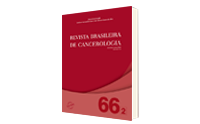Biophotometric Analysis of Shoulder and Elbow Movements Related to Functional Gains and Surgical Types in Women Undergoing Breast Cancer Surgery
DOI:
https://doi.org/10.32635/2176-9745.RBC.2020v66n2.895Keywords:
Mastectomy, Physical Therapy Modalities, Breast Neoplasm, Range of Motion, ArticularAbstract
Introduction: Breast cancer surgeries cause a reduction in shoulder range of motion (SRM) impacting its functionality. Biophotometry is a resource that can assess SRM, showing precision and reproducibility. Objective: To measure the shoulder and elbow range of motion and relate them to the functional gains after physiotherapeutic intervention and surgical type in women undergoing breast cancer surgery. Method: An analytical observational research, with 30 mastectomized women being monitored at the Uberlândia Cancer Hospital, Brazil, submitted to biophotometric evaluation with graduation marks at standardized points in the upper limbs (ULs) in order to analyze the SRM in frontal and profile view, apply the Disabilities of the Arm, Shoulder and Hand (DASH) questionnaire and questions about the daily activities by filling in an anamnesis form before and after four months of intervention. Results: There was a reduction in SRM in all shoulder movements, the means of abduction and flexion scores of the homolateral shoulder, before and after four months of physiotherapeutic intervention, were 130.3 and 149.4 degrees (p=0.002) and 128.1 and 140 (p=0.008), respectively. The DASH score decreased from 38.1 to 32.15 (p=0.047) and, in issues involving shoulder abduction and flexion, there was greater increase in the percentage of responses answering “no difficulties”, with mean from 23.08% to 42.86%. Conclusion: Shoulder abduction and flexion are the most altered movements in the homolateral limb to the surgery, however, after four months of physiotherapy, there was an improvement in the SRM, leading to functional gain, regardless of the surgery type.









